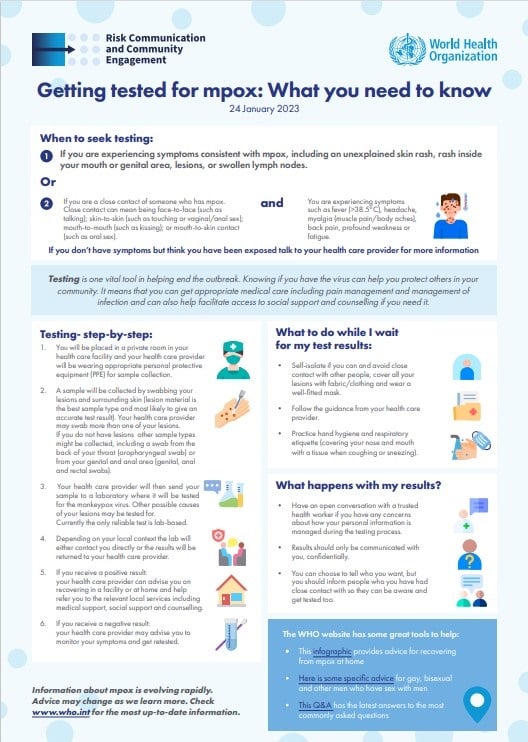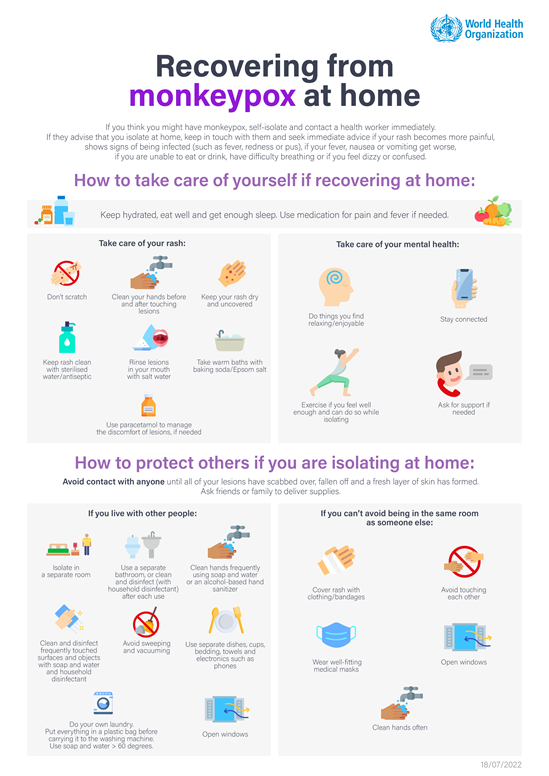The monkeypox virus is an orthopoxvirus that causes mpox (monkeypox), a disease with symptoms similar to smallpox, although less severe. While smallpox was eradicated in 1980, mpox continues to occur in countries of central and west Africa. Since May 2022, cases have also been reported from countries without previously documented mpox transmission outside the African region. Two distinct clades of the monkeypox virus have been identified: Clade I (previously known as the Congo Basin (central African) clade and Clade II (the former west African clade).
Mpox is a zoonosis, a disease that is transmitted from animals to humans, with cases often found close to tropical rainforests where there are animals that carry the virus. Evidence of monkeypox virus infection has been found in animals including squirrels, Gambian pouched rats, dormice, different species of monkeys and others.
The disease can also spread from humans to humans. It can be transmitted through contact with bodily fluids, lesions on the skin or on internal mucosal surfaces, such as in the mouth or throat, respiratory droplets and contaminated objects.
Detection of viral DNA by polymerase chain reaction (PCR) is the preferred laboratory test for mpox. The best diagnostic specimens are taken directly from the rash – skin, fluid or crusts, or biopsy where feasible. Antigen and antibody detection methods may not be useful as they do not distinguish between orthopoxviruses.
Mpox (monkeypox) presents with fever, an extensive characteristic rash and usually swollen lymph nodes. It is important to distinguish mpox from other illnesses such as chickenpox, measles, bacterial skin infections, scabies, syphilis and medication-associated allergies.
The incubation period of mpox can range from 5 to 21 days. The febrile stage of illness usually lasts 1 to 3 days with symptoms including fever, intense headache, lymphadenopathy (swelling of the lymph nodes), back pain, myalgia (muscle ache), and an intense asthenia (lack of energy). The febrile stage is followed by the skin eruption stage, lasting for 2 to 4 weeks. Lesions evolve from macules (lesions with a flat base) to papules (raised firm painful lesions) to vesicles (filled with clear fluid) to pustules (filled with pus), followed by scabs or crusts.
The proportion of patients who die has varied between 0 and 11% in documented cases and has been higher among young children.Treatment of mpox (monkeypox) patients is supportive dependent on the symptoms. Various therapeutics that may be effective against mpox are being developed and tested.
Prevention and control of mpox rely on raising awareness in communities and educating health workers to prevent infection and stop transmission.
Close contact with infected people or contaminated materials should be avoided. Gloves and other personal protective clothing and equipment should be worn while taking care of the sick, whether in a health facility or in the home.
For mpox infections resulting from a primary animal-to-human transmission, contact with sick or dead animals should be avoided, and all foods containing animal meat or parts need to be properly cooked before eating.
Populations have become more susceptible to mpox as a result of the termination of routine smallpox vaccination, which offered some cross-protection in the past. Vaccination against smallpox with first generation vaccinia virus-based smallpox vaccine was shown to be 85% effective in preventing mpox in the past. Family and community members, health workers and laboratory personnel who were vaccinated against smallpox in childhood may have some remaining protection against mpox.
Many years of research have led to development of newer and safer vaccines for smallpox, which may also be useful for mpox. There are 3 vaccines against mpox, although available in limited quantities, that some countries are recommending for vaccination of persons at risk.


